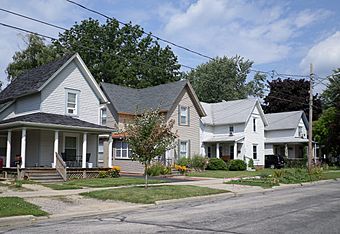Mason Street Historic Residential District facts for kids
Quick facts for kids |
|
|
Mason Street Historic Residential District
|
|
 |
|
| Location | Roughly bounded by Laverock Alley, Dewey, Hickory and Exchange Sts., Owosso, Michigan |
|---|---|
| Area | 7 acres (2.8 ha) |
| Built by | James Laverock |
| MPS | Owosso MRA |
| NRHP reference No. | 80001900 |
| Added to NRHP | November 4, 1980 |
The Mason Street Historic Residential District is a special neighborhood in Owosso, Michigan. It is known for its historic homes. This area is mostly made up of houses along Mason Street. It stretches between Dewey and Hickory Streets. This district was added to the National Register of Historic Places in 1980. This means it is an important place in American history.
History of Mason Street
The land where Mason Street is now was once a big fairground. It had a building for shows, a race track, and a tower for judges. But as the city of Owosso grew, this land became very valuable. People wanted to build homes and businesses there.
In the early 1890s, a builder named James Laverock saw this opportunity. He asked the city to sell him part of the fairgrounds. James Laverock was a well-known builder in Owosso. He had already built many other homes and shops. The city agreed to his request.
Because he was so important in the city, Laverock quickly built and sold homes. These were good, strong homes for working families. By 1900, many different people lived on Mason Street. They included a machine shop foreman and a dime store owner. There was also a master mechanic for the railroad. Carpenters, a college principal, and a watch-maker lived there too. Other residents included a bookshop owner, clerks, a baker, and a carriage painter. A salesman, a railroad worker, a janitor, a barber, and several widows also called Mason Street home.
What Mason Street Looks Like
The Mason Street Historic Residential District has 40 homes. Most of these houses were built in the 1890s. They are simple, affordable homes for working families. James Laverock built almost all of them. He used three main styles for his houses. The few other houses were built later, in the early 1900s. They fit in well with the older homes.
Most of the houses are on Mason Street. A few are on Oak Street, which is just north and south of Mason Street.
Laverock made each house a little different. He used various wood decorations. This helped them look unique.
- Style One: Nineteen homes have this style. They are two stories tall and shaped like an "L." They have wooden siding and a sloped roof. The front door is usually tucked into the "L" shape. They also have a small front porch.
- Style Two: Sixteen homes are built in this style. They are also two stories tall and shaped like a rectangle. They have wooden siding and a sloped roof. These homes have a small addition at the back. They have a simple front door and windows.
- Style Three: Only two homes use this style. They are two stories tall and rectangular. They have wooden siding and a sloped roof. These two houses have slightly more detailed windows. They also have a small front porch.

